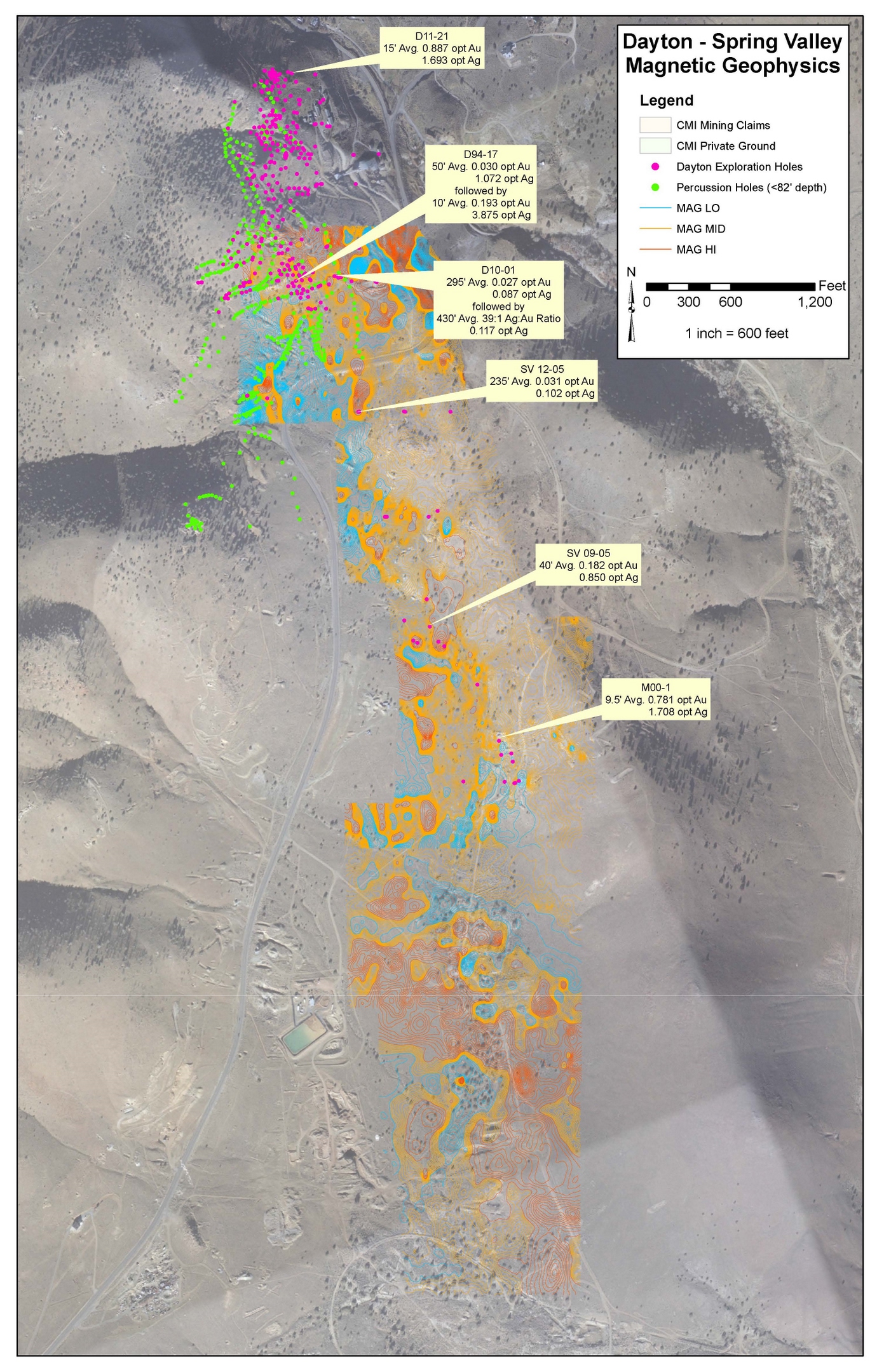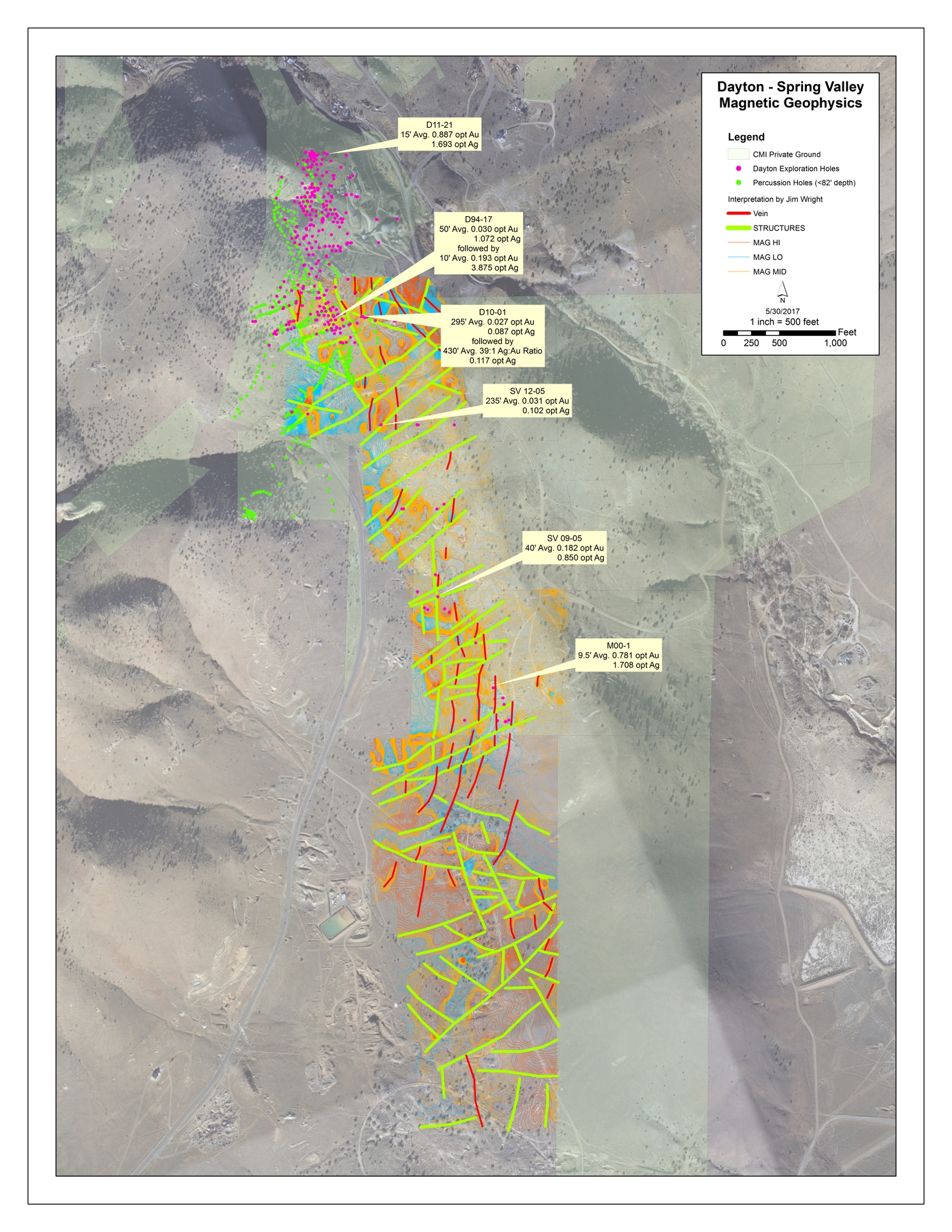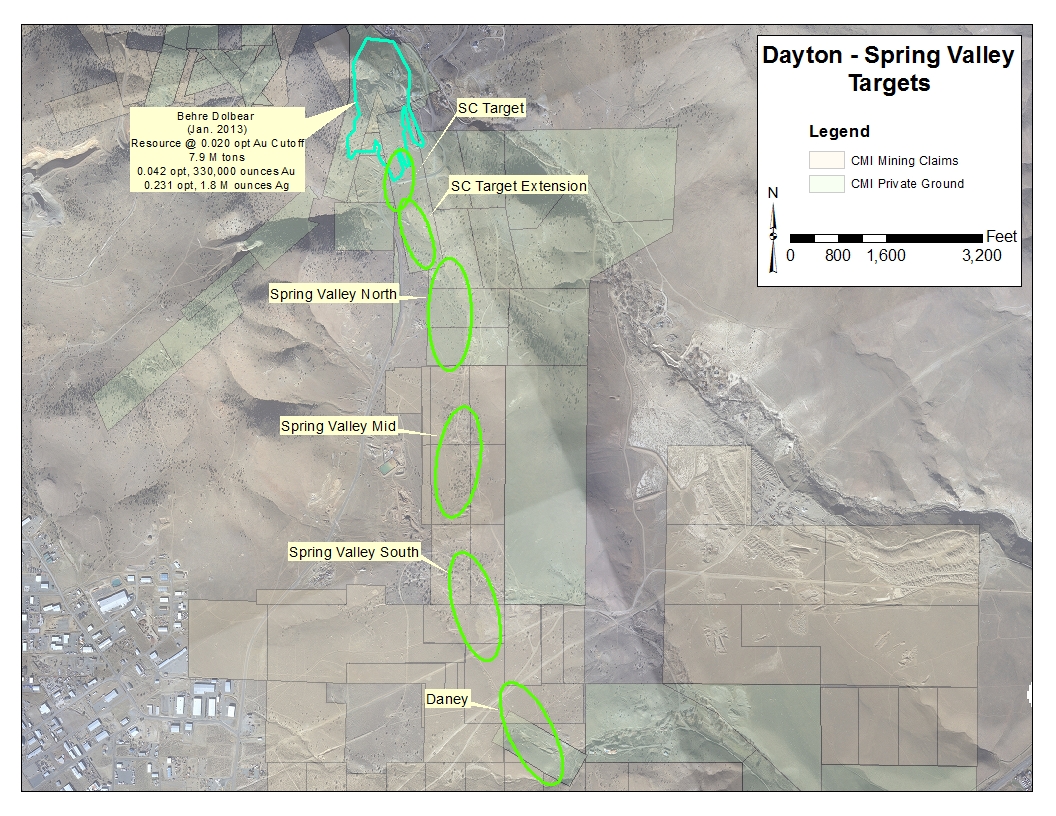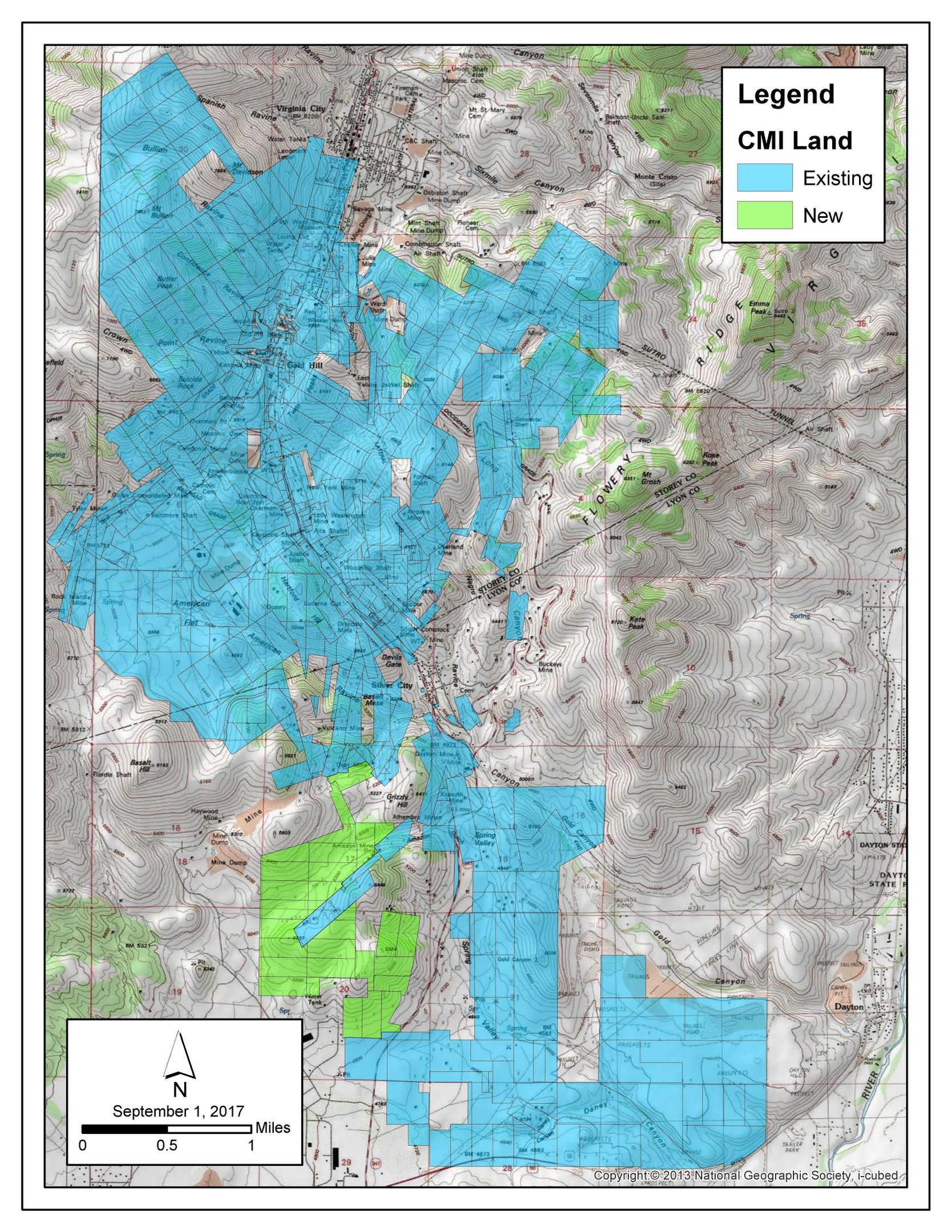Comstock Mining
Overview
Comstock Mining (LODE) is a Nevada-based, gold and silver mining exploration and development company with extensive, contiguous property in the historic Comstock and Silver City mining districts (collectively, the “Comstock District”). The Comstock District is located within the western portion of the Basin and Range Province of Nevada, between Reno and Carson City. The Company began acquiring properties and developing projects in the Comstock District in 2003. Since then, the Company has consolidated a substantial portion of the historic Comstock District, secured permits, built an infrastructure and brought exploration projects into production.
The Company’s headquarters, technical resources, mine operations and heap leach processing facility are located in Storey County, Nevada, at 1200 American Flat Road, approximately three miles south of Virginia City, Nevada and 30 miles southeast of Reno, Nevada. The Company now owns or controls approximately 9,284 acres of mining claims and parcels in the Comstock and Silver City Districts. The acreage is comprised of approximately 2,353 acres of patented claims (private lands) and surface parcels (private lands) and approximately 6,931 acres of unpatented mining claims, that the Bureau of Land Management (“BLM”) administers.1
The Company achieved initial production and held its first pour of gold and silver on September 29, 2012. The Company produced approximately 59,453 ounces of gold and 734,493 ounces of silver between 2012 and 2016. The Company achieved final recovery rates of 89% for gold and 60% for silver.
Because of the Comstock District’s historical significance, the geology is well known and has been extensively studied by it, its advisors and many independent researchers. Comstock Mining has expanded its understanding of the geology of the project area through vigorous surface mapping and drill hole logging. The volume of geologic data is immense, and thus far the reliability has been excellent, particularly in the various Lucerne Mine areas. Comstock Mining has amassed a large library of historic data and detailed surface mapping of Comstock District properties and continue to obtain historic information from private and public sources.
The company use such data in conjunction with information obtained from its current operations, to target geological prospective exploration areas and plan exploratory drilling programs, including expanded surface and underground drilling.
The Company continues evaluating and acquiring properties inside and outside the district expanding its footprint and exploring all of its existing and prospective opportunities for further exploration, development and mining. The near-term goal of its business plan is to maximize intrinsic stockholder value realized, per share, by continuing to acquire mineralized and potentially mineralized properties, exploring, developing and validating qualified resources and reserves (proven and probable) that enable the commercial development of its operations through extended, long-lived mine plans that are economically feasible and socially responsible. The company's goal is to deliver up to $500 million of accretive share value (over $2 per share) by 2020, by acquiring, exploring and developing resources and reserves capable of sustaining production of more than 100,000 gold-equivalent ounces per annum. The company's past efforts have positioned it for this success.
The current development priorities are in the Lucerne and Dayton Resource Areas, with both surface and underground development opportunities. The company also have longer-term exploration plans for the remaining areas, including the Spring Valley, Occidental, Northern Extension and Northern Targets areas.
Current Exploration Projects - District-wide
The Company's long-term plans contemplate the exploration and development of six major geological target areas across the District, which include: the Lucerne, Dayton, Spring Valley, Gold Hill Group (that is, both the Northern Extension and Northern Target areas) and the Occidental. These targets represent over 7 miles of mineralized strike length, with current and historic grades of gold and silver. Refer to Figure 1.
 Figure 1 - General overview of priority surface and underground targets.
Figure 1 - General overview of priority surface and underground targets.
Lucerne Resource Area
During 2016, the Company focused on exploration and development of certain properties within the Lucerne resource area (the “Lucerne Property”) , primarily underground core drilling, underground drift (tunnel) development, and underground sampling into the Quartz Porphyry (PQ) and Succor geological targets. Future drill programs were being developed with a phased approach to extend the PQ mineralization and scope the Succor and Woodville targets but the Company suspended those plans due to the higher than expected complexity of the underground development effort and the uncertainty about the total capital required for delivering a commercially viable mine plan. Ultimately, the Company decided to assess, evaluate and pursue partners willing and able to commit the additional mining expertise and capital resources required to explore and develop a commercially viable Lucerne-based mine plan.
On October 3, 2017, the Company entered into an Option Agreement (the “Option Agreement”) with Tonogold Resources, Inc. (“Tonogold”). Under the terms of the Option Agreement, Tonogold will have the right to participate in certain activities, including but not limited to, engineering, development, drilling and test-work, towards completing a technical and economic feasibility assessment on certain properties within the Lucerne Property and if all obligations and prerequisites are satisfied and subject to compliance with the Option Agreement, Comstock and Tonogold may effect a joint venture for the future development and mining of mineral resources on the Lucerne Property.
Under the terms of the Option Agreement, Tonogold can earn a 51% interest in the Company’s presently wholly-owned subsidiary, Comstock Mining LLC, which owns the Lucerne Property, by making capital expenditures on the Lucerne Property of $20 million no later than 42 months following signing of the Option Agreement and payments of $2.2 million to the Company. The initial payment of $0.2 million was paid by Tonogold to the Company at the time that the Option Agreement went into effect. If Tonogold elects to proceed with the project, Tonogold would have to make another payment of $2 million within the six-month period following the date that the Option Agreement was signed.
If Tonogold does not elect to extend the option beyond the initial six months, it will be required to make a further payment to the Company equal to $1 million less Tonogold’s actual expenditures on the Lucerne Property during such initial six-month period. In addition, Tonogold is granted the option to purchase 51% of certain equipment and property located at the Company’s American Flat property for a purchase price of $25 million. Tonogold is also granted a right of first refusal if the Company elects, in its sole discretion, to sell certain mining properties.
The Option Agreement calls for a Technical Committee composed of three Tonogold participants and two Comstock participants to oversee all of the engineering, development, drilling and test-work activities, and others, towards completing a technical and economic feasibility assessment. The Technical Committee is scheduled to review the first phase of the drilling program during the first week of November 2017.
Dayton Resource Area and Spring Valley Targets
The Company plans to advance the Dayton Resource area to full feasibility, with a production ready mine plan within the next two years. The volcanic host rocks and structural controls of the mineralization defined, to date, for the Dayton Resource area are also projected south into the Spring Valley target area. Economic gold mineralization has been intercepted in several wide spaced drill holes conducted during numerous prior Spring Valley drilling programs. Over the past several months, the technical staff has identified multiple drill targets within several specific locations that encompass the Dayton Resource area and potentially extending for an additional 7,500 feet of mineralized strike length, into Spring Valley. The new targets are based on the Company's latest review of previous geophysical studies and current interpretation of the geology. The Dayton and Spring Valley southern expansion programs includes exploration and definition drilling of targets identified by the prior conventional percussion, RC and diamond core drill programs and magnetic, IP and resistivity geophysical surveys (Figure 2).
 Figure 2 - Dayton -Spring Valley Magnetic Geophysics
Figure 2 - Dayton -Spring Valley Magnetic Geophysics
Several historic mines operated in the Dayton Resource area, leaving access to multiple structures from underground. Some historic adits have remained open or have been uncovered by the Company. The geologic and engineering team completed underground mapping, sampling, and surveying in a number of historic mine tunnels on and near the Dayton Resource area. Where accessible, the workings were inspected; geology mapped and mineralized material sampled. Once sampling was completed, the workings were surveyed to document the size of the mine workings, the location of the openings and location of the samples. The samples were then assayed at the Company’s in house metallurgical laboratory for gold and silver.
This underground sampling program has provided a wealth of assay information and provided critical information for furthering the geologic understanding of the Dayton Resource area. In some cases structures identified on the surface were traced underground and in other cases new structures were identified underground where surface expressions were absent or obscured.
Ground magnetic geophysical surveys identified a linear anomalous corridor, defined by a series of relative magnetic lows. Altered volcanic host rocks have been intercepted by limited drilling and identified several mineralized zones. Selected drill hole intercepts are highlighted (see Figure 3). Additionally, a wide zone (up to 500 feet wide) beginning at the Dayton Resource and continuing southerly, all the way down to the Daney mineralized patent can be traced by following the north/south trending vein swarms (see again, Figure 3). The veins depicted by distinct traces colored red. The increased occurrences and density of the combined structures has been indicative in the Dayton Resource to host the higher grades and larger volumes of economic mineralization. This will be part of the exploration model and has generated a multiple drill target environment.
The Dayton Resource exploration program is designed to target the projected trend of known mineralization southerly. The magnetic geophysical survey has been studied and a structural interpretation was developed that illustrates multiple cross cutting structures (colored green) that are oblique to the southerly projected vein trend (colored red). Though rare, due to alluvial cover, the outcropping quartz veins and outcropping crosscutting structures had definitive diagnostic magnetic signatures. The interpretation of the structures and veins were derived by connecting these specific magnetic attributes as identified on each 25 meter spaced survey line. Similar structures have been identified in the Dayton Resource area and were found to be important components for the development of economic grades of mineralization. In the Dayton Resource area, geologic observations made on the surface and in accessible underground workings have identified the north/south and the crosscutting structures to carry gold and silver values with different silver to gold ratios. Comparisons of selected sample geochemistry, the north/south veins commonly have a higher silver to gold ratio.
The Company also recently completed metallurgical column tests on mineralized material from the Dayton Resource area that contribute to the advancement of a full feasibility assessment for the mine, updating prior metallurgical test work and the technical resource report published in January 2013. During the second quarter of 2017, the Company conducted column tests of both cyanide and non-cyanide solutions. They established four, full metallurgical column tests, two cyanide and two non-cyanide, running parallel, that supports and advances the feasibility study for establishing proven and probable reserves at the Dayton Resource. The samples were crushed, agglomerated and loaded into four ten-foot columns for leach simulation. These simulations were conducted on-site, in the Company’s metallurgical labs, and are coordinated through Cycladex Inc., (“Cycladex”) a strategic investee, and funded by U.S. National Science Foundation grants.
The Cyanide columns yielded between 82-85% gold in just 25 days. The Company has already designed and established new column tests for the primary purpose of assessing the specific consumption of the new materials and material cost for processing. This is important for assessing ultimate economic feasibility of these solutions. These simulations will also be conducted on-site, in the Company’s metallurgical labs, and are still funded by U.S. National Science Foundation research grants. These updated metallurgical testing compliment extensive metallurgical testing for the Dayton Resource that were previously published in 2011.
 Figure 3 - Dayton and Spring Valley Magnetic Geophysics
Figure 3 - Dayton and Spring Valley Magnetic Geophysics
In house Dayton engineering and mine planning have resulted in profiling various economic pit shells with multiple cutoff grade scenarios. Multiple layout plans for the mine and corresponding processing facilities have been conceptually developed and located on lands 100% privately held by the Company, thus simplifying and shortening the critical permitting chain. A definition drill plan is in place and is permitted. An expanded drill plan is currently being designed and detailed plans will be submitted to the regulatory agencies for permitting.
In addition to infrastructure and drill planning, the company performed due diligence assisted by SRK Consulting. The due diligence resulted in confirmation of the scoping level mine plans and agreement on the conceptual processing layout. The Company plans to conduct definition drilling and geo technical core programs within the Dayton Resource area, as previously described, and advance this area to full feasibility, with a production ready mine plan within the next two years
 Figure 4 - Dayton and Spring Valley Target
Figure 4 - Dayton and Spring Valley Target
During the third quarter, the Company completed a study of lands open to mineral entry near the Company's southern Dayton Resource and Spring Valley exploration target. Thirty lode claims were located, perfected and filed with Lyon County and the Bureau of Land Management. The recently staked lode claims were positioned to control lands hosting favorable geology and provide an additional contiguous corridor to its northern land holdings located west of State Route 341. The block of new claims adds approximately 470 net acres to the Company's already significant land position in the historic Comstock District. Exploration efforts will now be expanded and include the new, adjacent claims.
 Figure 5 - illustrates the Company's existing and new land position.
Figure 5 - illustrates the Company's existing and new land position.
During the year ended December 31, 2016 and fully continuing through the third quarter of 2017, the Company focused on reducing all costs, including mining, real estate, exploration and mine development, mine claims, environmental and reclamation and general and administrative costs. Total costs and expenses have declined by over $5.3 million when comparing the nine-month period ending 2016 to the nine-month period ending 2017, and the Company expects total year on year savings to exceed $6 million when comparing the full year of 2017 to 2016. The Company has aggressively implemented organizational changes consistent with the transition from mining the Lucerne surface mine to growing its resource portfolio and related exploration and development activities toward production-ready mining projects.
The Company has reduced operation costs in all categories and already is achieving the run rate of those costs for the second half of the year to be $3.6 million, or less than $290,000 per month (excluding depreciation, amortization, and depletion expense). The recently announced agreement and current collaboration with Tonogold has the potential for reducing the annual expenses, in 2018, by over an additional one-third, or $1.25 million in reductions. This would reduce the monthly operating expense to less than $200,000 per month (excluding depreciation, amortization, and depletion).
The Company is working on additional initiatives for further reducing those costs while fully maintaining its operating and permitted infrastructure. Operating expenses for the full year 2017, mainly due to higher expenses associated with restructuring and refinancing activities that are now complete, are anticipated to be $4.5 million, excluding $4.4 million in depreciation and $1.3 million of interest expense. First half and second quarter costs, including real estate operating costs, mine claim and all general and administrative costs were lower, period on period, and are expected to continue to decrease over the last quarter of 2017, given the relatively higher administrative costs associated with its third quarter 2017, effort to effect the Tonogold agreement.
Outlook
The company's goal is to deliver up to $500 million of accretive share value (over $2 per share) by 2020, by acquiring, joint venturing, exploring and developing resources and reserves capable of sustaining production of more than 100,000 gold-equivalent ounces per annum. The company's past efforts, especially during the past 18 months, have positioned it for this success. These production targets include both the Lucerne and Dayton Mine plans, with both surface and underground development opportunities.
Total operating expenses (excluding depreciation, amortization, and depletion expense) for the last quarter of 2017 are expected to be less than $1.0 million, with a sustainable, annual run rate of $3.6 million. The Tonogold agreement, if the second phase is exercised, has the potential for reducing these annual operating expenses (excluding depreciation, amortization, and depletion expense) of $3.6 million, in 2018, by an additional $1.25 million. Interest expense is expected to be approximately $1.3 million for 2018. The Company expects to continue operating with approximately 10 employees, including expert land, permitting, geology, engineering and metallurgical professionals.
The Company plans to sell non-mining related lands, buildings and water rights, for expected net cash proceeds of approximately $14 million during the next twelve months resulting in a net gain of approximately $8 million. These proceeds will first be used to eliminate debt obligations due under the Debenture (including principal, accrued interest, and make whole amounts), and to fund certain exploration activities in the Dayton Resource area, all while strengthening the financial position of the Company.
The Company has also commenced and plans on continuing metallurgical testing on Dayton mineralized materials, using both cyanide and non-cyanide alternative solutions to experiment on achieving the highest, most cost efficient processing for the Dayton feasibility assessment. The Company will also commence Reverse Circulation (RC) drilling at the Dayton mine sufficient to finalize the parameters of a mine plan and commence the permitting for the Dayton mine. Infill drilling is expected to significantly expand the reserve potential for the Dayton mine plans. The Company has developed grade shells with higher average grades and believes the Dayton to have economically feasible potential and plans on developing those mine plans toward full feasibility during late 2017 and early 2018, with production plans following those efforts within the next two years.
The Company will report the results of the Lucerne exploration and development programs, in conjunction with Tonogold, and independently for Dayton exploration and development programs, as they become available.
For the three-months ended 2017, the Company issued 17,967,995 shares of common stock through the Company’s at-the-market equity offering program and its equity purchase agreement. Gross proceeds from the issuance of shares totaled approximately $3.2 million at an average price per share of $0.178 .
For the nine-months ended 2017, the Company issued 35,206,738 shares of common stock through the Company’s at-the-market equity offering program and its equity purchase agreement. Gross proceeds from the issuance of shares totaled approximately $5.9 million at an average price per share of $0.166 .
In October 2017, the company issued approximately 2,422,150 shares for proceeds of approximately $0.4 million.




